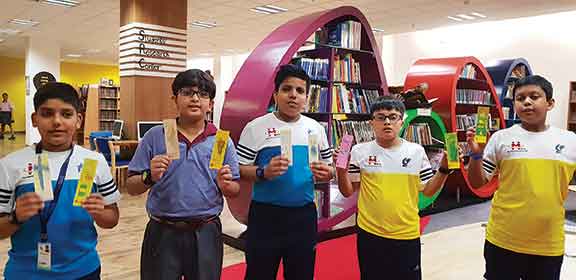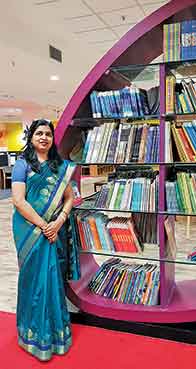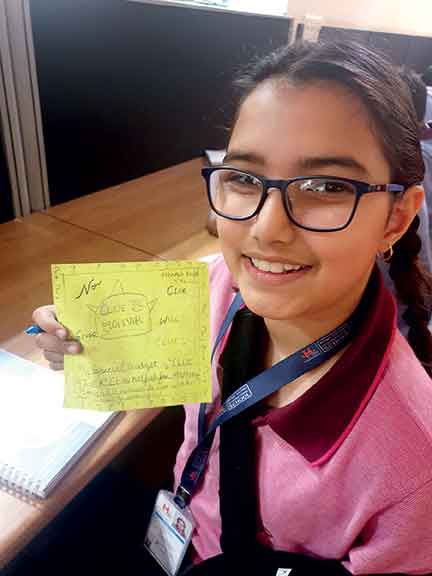Chhavi Jain
Most parents and educators are worried about their children’s waning interest in reading. The main task is not only to get them to start reading but also to enjoy it. According to a report by The National Literacy Trust, “A lifetime reader is based on developing a deep love of reading.”
“Research has repeatedly shown that motivation to read decreases with age, especially if pupils’ attitudes towards reading become less positive. If children do not enjoy reading when they are young, then they are unlikely to do so when they get older.”
To attract infants, toddlers and kindergarten students, colourful books with large fonts are available in the market. Generally parents of pre-primary and primary students are very enthusiastic about selecting and reading books with their young children but slowly this reading time starts vanishing from their lives as the children grow older. Schools are organizing various programs and workshops to make parents aware of the crucial role of the family and home environment in the scholastic achievement of children.

In middle school, it is very easy to identify readers and non-readers. As per our observation in school, out of 30 students in 7th class, 45 per cent students like to read but need guidance, 35 per cent don’t like to read and 20 per cent students are self-motivated. As a librarian, I think this 45 per cent of the students can be the prime target who need a little push and the right guidance to start reading.
Articles written by Krashen (2011) on the concept of free voluntary reading and Allington (2012) on high success reading should be referred to by teacher librarians to know various strategies to deal with non-readers. These articles emphasize reading for pleasure and in general this is an area overlooked in schools. A wrong approach can aggravate the problem, so a librarian must be confident before intervening. Our main objective must be to give an opportunity to develop the reading habit and to set a standard to measure this success.
Step 1: Collect data
Meeting with students on a one-to-one basis helps to understand their personality and personal interests. Interview is the best way to build a reading relationship with each student. Some open-ended questions can be asked to make them think about their reading interest. Questions can be: why do you think you are on the list of non-readers? Do you think reading makes you smarter? How do you define reading? At the end of the session, explain to them that the goal of the interview is to make reading enjoyable for them. The interview can also include questions to find their personal interests, likes and dislikes. This kind of individual discussion can help create trust. Reading recommendations can be built on the basis of this interview.
Step 2: Giving reading recommendations
The wrong recommendation or approach can ruin the aim of the project. The librarian should be very clear with her reading recommendations. For example, children are forced to read the classics in high school but they contain tough language and require loads of prior knowledge. For new readers classics can sometimes be hard to understand and even harder to read with interest. Following are some books for middle and high school students to create an interest in reading.
 a. Moneyball by Michael Lewis (non-fiction)
a. Moneyball by Michael Lewis (non-fiction)
Lewis examines how in 2002, the Oakland Athletics team achieved a spectacular winning record while having the smallest player payroll of any major league baseball team (www.publishersweekly.com/978-0-393-05765-2)
This revolutionized thrilling story explains Billy Beane’s (former American baseball player) mathematical approach to winning the game. It’s a must-read book for sports lovers and particularly baseball fans.
b. The Fight by Norman Mailer (non-fiction)
The Fight is a story of sportsmanship. Once one starts to read this, no one can leave in between. This is the story of Muhammad Ali and George Foreman in their heavyweight title clash in Zaire (past territory of the Congo).
c. The Test of My Life: from Cricket to Cancer and Back by Yuvraj Singh
This book is the true story of Yuvraj Singh, Indian cricketer and cancer survivor. He was born in Chandigarh in 1981 and started playing for India in 2000. In 2011 he played a lead role to help India win the ICC World Cup. Soon after, he was diagnosed with cancer. This book contains the story of his life as a player and as a cancer survivor.
For Adventure lovers
d. The Hunger Games by Suzanne Collins (Fiction) and Divergent by Veronica Roth (fiction)
Fiction for young adults, particularly young women, who are looking for books with female protagonists.
e. Looking for Alaska and Fault in our stars by John Green (fiction)
These books tell emotional, heart touching stories of new friendship and enigmatic lives of young adults.
More ways to encourage reading
Book intro
The librarian can introduce a book through BOOK TALK. In a small group of students, introduce a book by reading its summary; explain character traits, read book reviews written by famous personalities. A discussion on books of the same segment or genre to check students’ knowledge and interest can be organized by the librarian while introducing a new title. If available, play an online book trailer before discussing the book. If possible contact the author and arrange an author talk, If the author can’t visit your school, there is always video conferencing.
These ways are really effective in introducing a book and non-readers can be attracted towards books if they have some prior knowledge about the book, story or author.
a. Popular books
Some books are based on popular movies or TV shows or vice versa. Recommending titles like Titanic, Jurassic Park, Life of Pi or Harry Potter is sometimes a good choice to achieve success.
b. Award winning books
For students who don’t have any specific interest, award winning books can do wonders. Holding an award winning book with a golden or silver colour award badge on the cover gives a feeling of pride to students. With little intervention at that time by the teacher, librarian or parent, non-readers can be converted into regular readers.
 Step 3: Evaluation
Step 3: Evaluation
Evaluations can be done in the following ways
- Observe students passively during a reading session. A reading session can be of 5 mins in the beginning and can extend up to 45 mins in school. After that as per the student’s interest, books can be issued for reading after school hours.
- After the reading session, a brief discussion about the recommended book should be conducted by the librarian. Find out if they like something similar or different to read.
Step 4: Observation
1. No of pages read during a reading session.
2. Body language while reading.
3. Ability to explain what they read.
Conclusion
Properly customized intervention to change one’s perspective about books and reading combined with a range of books can make a difference. In general reading recommendations, summer reading lists and daily suggested reading books list is shared by the classroom teacher or language teacher but intervention with personalized book recommendations is helpful to build a good reading relationship.
References
- Allington, Richard L. and Gabriel, Rachael E. (2006). Every Child, Every Day. Reading. The Core Skill. March 2012. Vol 69 (6). P 10-15. Retrieved from http://www.ascd.org/publications/educational-leadership/mar12/vol69/num06/Every-Child,-Every-Day.aspx
- Krashen. Stephen (2011). What Does it Take to Develop a Long-term Pleasure Reading Habit? Turkish Online Journal of English Language Teaching. 1 (1). 1-9, 2016. Retrieved from http://www.sdkrashen.com/articles.php?cat=2
- Mueller, P.N (2001). Lifers: Learning from at-risk adolescent readers. Heinemann.
- Smith, M., and Wilhelm, J.D. (2002) Reading Don’t Fix No Chevys; Literacy in the Lives of Young Men. Portsmouth: Heinemann. Bose State University. Retrieved from www.heinemann.com/products/0509.aspx
- Tatum, A. (2005). Teaching reading to black adolescent males. Portland, Stenhouse
The author is a librarian at Manav Rachna International School, Gurugram, Haryana. She can be reached at chhavimjain@gmail.com.
